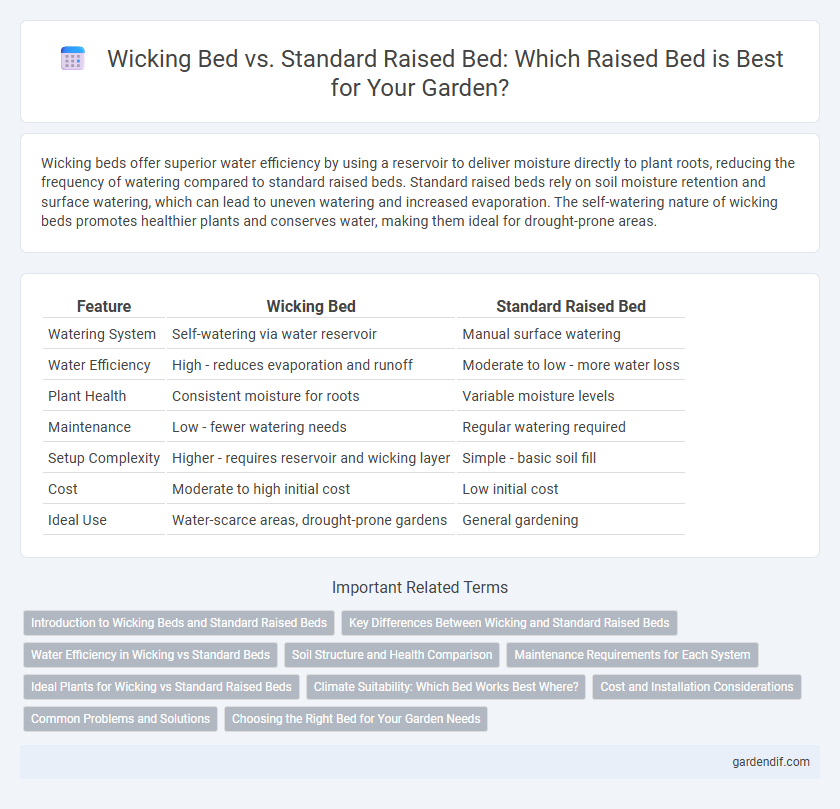
Wicking bed vs Standard raised bed Illustration
Wicking beds offer superior water efficiency by using a reservoir to deliver moisture directly to plant roots, reducing the frequency of watering compared to standard raised beds. Standard raised beds rely on soil moisture retention and surface watering, which can lead to uneven watering and increased evaporation. The self-watering nature of wicking beds promotes healthier plants and conserves water, making them ideal for drought-prone areas.
Table of Comparison
| Feature | Wicking Bed | Standard Raised Bed |
|---|---|---|
| Watering System | Self-watering via water reservoir | Manual surface watering |
| Water Efficiency | High - reduces evaporation and runoff | Moderate to low - more water loss |
| Plant Health | Consistent moisture for roots | Variable moisture levels |
| Maintenance | Low - fewer watering needs | Regular watering required |
| Setup Complexity | Higher - requires reservoir and wicking layer | Simple - basic soil fill |
| Cost | Moderate to high initial cost | Low initial cost |
| Ideal Use | Water-scarce areas, drought-prone gardens | General gardening |
Introduction to Wicking Beds and Standard Raised Beds
Wicking beds are self-watering raised beds designed with a water reservoir beneath the planting area, allowing plants to draw moisture upward through capillary action, reducing water waste and promoting consistent hydration. Standard raised beds consist of elevated soil contained within a frame, relying on surface watering methods that can lead to uneven moisture distribution and increased evaporation. The key difference lies in the irrigation efficiency, with wicking beds offering improved water conservation and healthier root systems compared to traditional raised beds.
Key Differences Between Wicking and Standard Raised Beds
Wicking beds feature a built-in water reservoir that allows plants to draw moisture from below, promoting efficient water usage and reducing surface evaporation compared to standard raised beds. Standard raised beds rely on top-down watering, which can lead to uneven soil moisture and increased water runoff. The ability of wicking beds to maintain consistent soil moisture supports healthier root development and lowers the frequency of irrigation.
Water Efficiency in Wicking vs Standard Beds
Wicking beds significantly enhance water efficiency by using a self-watering system that draws water up through the soil via capillary action, minimizing evaporation and runoff. Standard raised beds rely on surface watering methods, which often result in higher water loss and less consistent soil moisture. Studies show wicking beds can reduce water usage by up to 50% compared to traditional raised beds, making them more sustainable for drought-prone areas.
Soil Structure and Health Comparison
Wicking beds feature a specialized water reservoir beneath the soil, promoting consistent moisture levels that enhance soil structure by reducing compaction and encouraging beneficial microbial activity. Standard raised beds rely on surface watering, which can lead to fluctuating soil moisture and increased risk of soil crusting or erosion, negatively impacting soil health. The enhanced water retention in wicking beds supports nutrient availability and improves root aeration, fostering a more balanced and fertile soil ecosystem compared to traditional raised beds.
Maintenance Requirements for Each System
Wicking beds require less frequent watering compared to standard raised beds due to their self-watering mechanism that draws moisture from a reservoir beneath the soil. Standard raised beds need regular irrigation, especially during dry periods, to maintain consistent soil moisture for plant health. Both systems demand routine monitoring for pests and soil fertility, but wicking beds generally reduce maintenance efforts related to watering.
Ideal Plants for Wicking vs Standard Raised Beds
Wicking beds excel in growing water-loving plants such as tomatoes, cucumbers, and lettuce due to their self-watering design that maintains consistent moisture levels. Standard raised beds are more versatile, supporting a wider variety of plants including root vegetables like carrots and potatoes, which benefit from well-drained soil conditions. Choosing the right bed depends on the plant's water requirements and root growth characteristics for optimal yield and health.
Climate Suitability: Which Bed Works Best Where?
Wicking beds excel in hot, arid climates by providing consistent moisture through a self-watering reservoir, reducing water stress on plants and improving drought resilience. Standard raised beds perform well in temperate and cooler regions where rainfall is more predictable, allowing for easier drainage and simpler irrigation methods. Selecting the right bed depends on local climate patterns, with wicking beds ideal for dry areas and standard raised beds better suited for moist or variable climates.
Cost and Installation Considerations
Wicking beds typically have higher upfront costs due to the need for a waterproof liner and a water reservoir construction, while standard raised beds are generally more affordable and easier to build using basic materials like wood or metal. Installation of wicking beds requires careful planning to ensure proper layering for water retention and soil absorption, whereas standard raised beds involve simpler soil filling without specialized water management. The added complexity of wicking beds can lead to longer installation times and potential maintenance costs, making standard raised beds more cost-effective for beginners or budget-conscious gardeners.
Common Problems and Solutions
Wicking beds address common problems of water wastage and inconsistent soil moisture in standard raised beds by incorporating a water reservoir beneath the soil layer, promoting self-watering through capillary action. Standard raised beds often face issues like soil drying out too quickly and higher water frequency, which can be mitigated in wicking beds through efficient water use and reduced evaporation. Both systems benefit from using mulch and appropriate soil mixes, but wicking beds excel in drought-prone areas due to their consistent moisture delivery and lower maintenance requirements.
Choosing the Right Bed for Your Garden Needs
Wicking beds offer efficient water conservation by delivering moisture directly to plant roots through a reservoir system, making them ideal for drought-prone areas or gardeners seeking low-maintenance irrigation. Standard raised beds provide excellent soil control and flexibility in planting but require more frequent watering compared to wicking beds. Selecting the right bed depends on your garden's water availability, maintenance capacity, and specific crop requirements to optimize growth and resource use.
Wicking bed vs Standard raised bed Infographic

 gardendif.com
gardendif.com